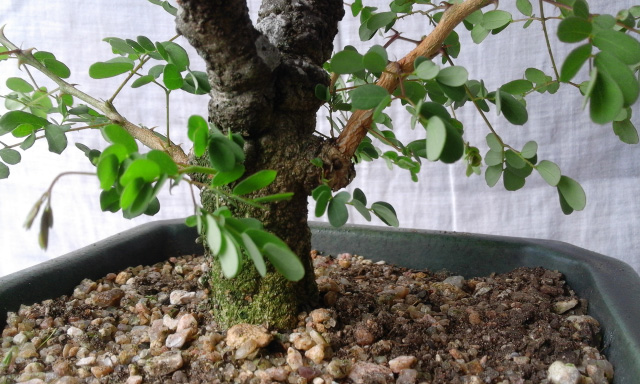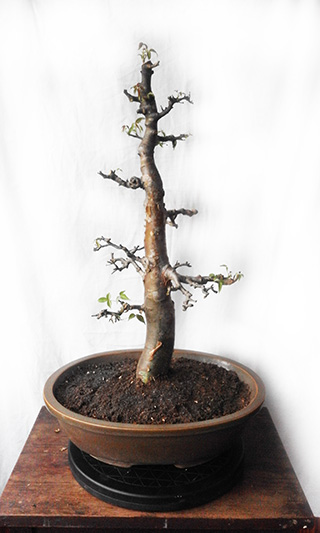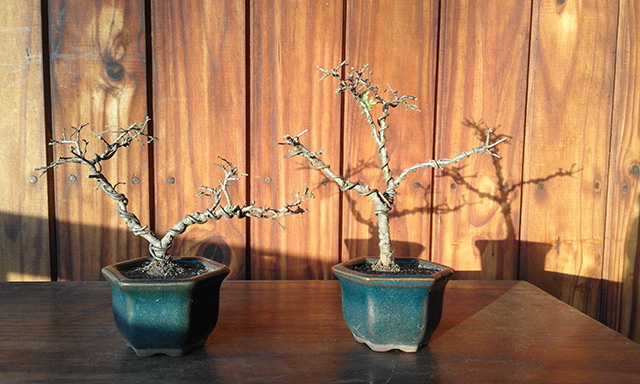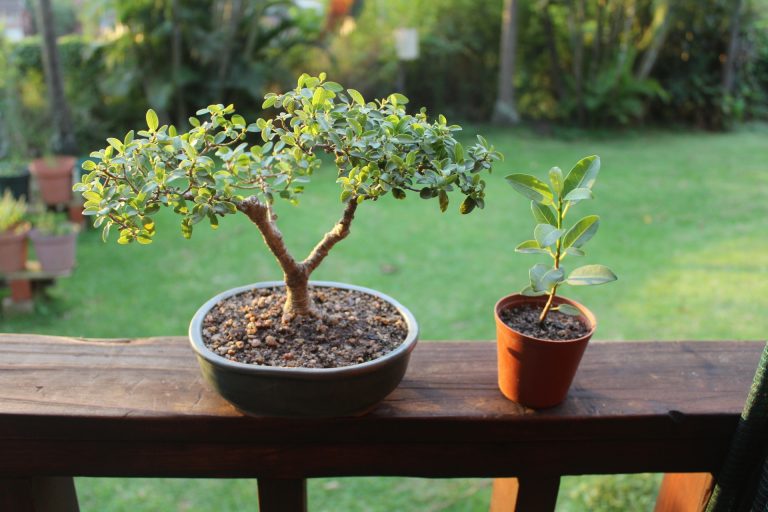Bad Branches – A Bonsai How To

Work on the structure of the branches of bonsai trees during winter.
The leaves of deciduous trees fall off during autumn. We can see the branch structure more clearly in winter than at any other time. We can easily distinguish the good branches from the bad ones and remove the bad ones. However, if you need to do a major reshape then rather leave the job till early spring. Wait for the new shoots to emerge. Plants recover from major surgery more quickly in spring. It should be fine to do small refinements during winter because it will not put any strain on the tree.
Distinguishing bad branches from good ones
Leonardo Da Vinci was once asked, apparently, how to carve an elephant from a block of stone. He replied, “The elephant is already inside the stone. One just has to remove the bits of stone that are not part of the elephant”. I expect the above story is not really true but it does illustrate the solution. Bad branches are simply any branches that detract from the aesthetics of the shape or style. A lot will depend on what the bonsai artist is trying to achieve. Very often it is fairly clear as to which branches do not belong. Remove those and one is well on the way to creating a beautiful bonsai.
Bonsai are often compared to the human body
A healthy branch structure is one where the branches all tend to radiate away from central points. We often compare this to the fingers on a person’s hands. An arthritis sufferer often has fingers that cross over each other, or curl up tightly. Both of these forms often manifest themselves in the branches of trees. When more than one branch crosses over another, the artist must decide which branches to remove to achieve the radiating finger structure. This radiating structure gives space to allow for the balanced development of the branches
Armpit branches
Armpit branches are branches that emerge from the middle of the fork of two other branches, or on the inside of a curve. After a little bit of practice they are quite easy to spot. Remove them and immediately the structure will improve. In addition, all branches should grow away from a tree’s trunk, not toward it. Occasionally some unusual styles might have branches growing toward the trunk, but this is not common. Remove any branches that grow inwards toward the trunk.
Tree Growth Patterns
All trees develop their own growth patterns, some might have a dense compact growth pattern with tortuously curled branches. Others might have more flowing lines, with elegance and grace. Generally the growth pattern should be the same throughout the entire tree. It probably would not look good if a tree that had predominantly curly branches had one very straight boring branch. That would look out of place, as would the reverse. Remove anything that is not part of the elephant.
Remove branches that grow directly up or down
Branches that grow directly up or down are also not really part of the elephant either. Branches grow up toward the sun. This is called positive phototropism. On large trees, any branch that emerges on the underside of a branch has to grow around that main branch in order to grow upwards. Branches like this seldom survive for long. Consequently, we don’t see these frequently. Therefore they are not part of our criteria of what makes for a beautiful looking tree. However, because bonsai are so small it is much easier for these branches to survive. They grow in what we might call unnatural directions. Remove all branches that emerge from the underside of a main branch.
Leaf pads grow upward
Upward growing branches fall into two categories. Remove large branches that grow straight up because they will rob the rest of the tree of nutrients. Their tips will grow vigorously, and in a way will become too healthy and too successful. When we build the branch structure we are essentially trying to achieve horizontal side branches with leaf pads at the very ends. However, the small branches at the ends of the main branches must grow upward. This exposes their leaves to the sun. Nip the tips of these small branches regularly to prevent any of them from growing out. If they do, they will gain dominance over the others. This regular nipping, especially during spring, will eventually create wonderfully dense and bushy leaf pads or clouds.
Ramification
The principle that the tree’s trunk should be the thickest part of the tree, the side branches narrower than the trunk, with the thickness of the subsequent branches thinner still, the thinnest and most delicate being at the very ends of the branches, is called ramification. The better the ramification the better the foliage pads.
Handle-bar branches
Handle-bar branches are the bane of all bonsai growers. The term refers to the situation where two branches emerge from opposite sides of a main branch at the same level. They can look a bit like a cartoon version of a fish bone, and they are often called fishbone branches. Handle-bar branches do not look good. Visually, our eyes prefer to see branches that are staggered in placement up the trunk. The lower branch on the left (or right), the next branch further up the trunk on the opposite side, the third branch towards the back. This looks something like the stairs of a spiral staircase.
When faced with handle-bar branches the artist should remove at least one of them.
Incidentally, back branches are often kept much shorter than the side branches. This is simply to reduce the actual depth of the tree. It is as much of a practical consideration as it is for aesthetics. A shorter back branch reduces the chance of damage.
Eye-pokers
Branches that grow toward the viewer are normally situated towards the top of the tree, and are also kept relatively short. Long branches that grow toward the viewer are called eye-pokers for obvious reasons, and one can tell just from the name that eye-pokers are not desirable. It is a bit like somebody pointing their finger in the proximity of one’s eyes. We would normally not have frontward pointing branches low down on the tree because the foliage of that branch would obscure the view of the trunk, which, on most bonsai, is the most eye-catching aspect. However, a devious and skilled artist might use a front branch to hide a “flaw”, like a bad scar for example. We use selective pruning and styling techniques to expose the beautiful and hide the “imperfections”.
Love your trees in winter
To finish, Just because it is winter and our trees do not have foliage is not an excuse to not spend time with them. The Japanese admire their trees in winter, bare of foliage, as much as they do in summer when they are full of leaves. In some way this acknowledges that everything is temporary in nature, that autumn follows summer, that winter follows autumn, and that spring will always follow after winter. The cycle of nature in turn reflects the cycle of our lives, and we can take heart that no matter how bad our circumstances may be, spring will always follow winter.
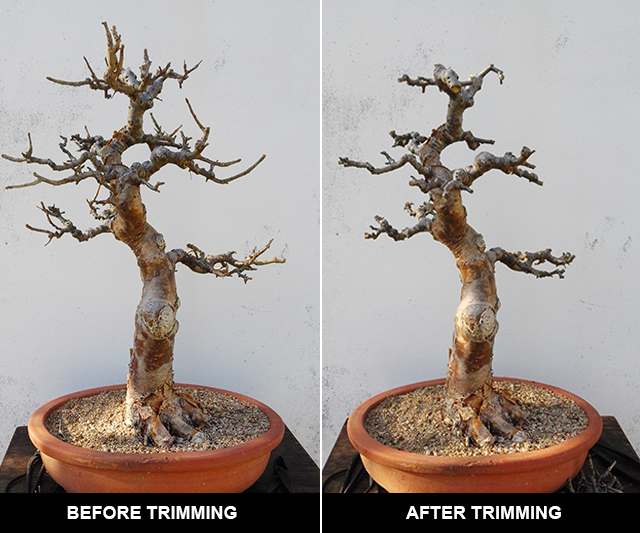
Ficus bonsai update
Keeping track of the progress of my little ficus potensai (bonsai to be). . A month and a half after giving it a fairly extreme cut back, it has developed a bunch of new shoots and one dominant shoot with huge leaves. The big leaves indicate that the plant is in a vegetative phase meaning that it is using all available resources to grow shoots and leaves. A plant will employ this survival technique whenever it feels threatened. It will continue producing large leaves for a year or two, and only when it feels it is not under threat will it begin to produce more numerous smaller leaves (mature phase) and begin to become a bonsai. I have selectively removed some of the new shoots at the base, and cut back the main shoot. At this stage it appears that it will become a small bonsai with three trunks.
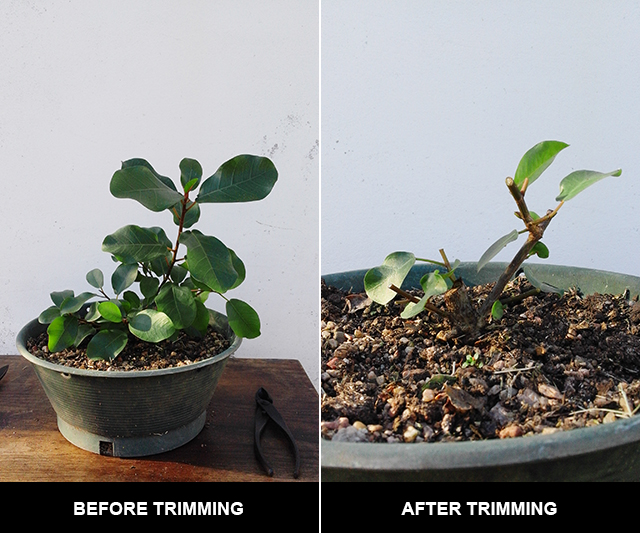
And that is my lot for today. Till next time, keep growing. – Gary

